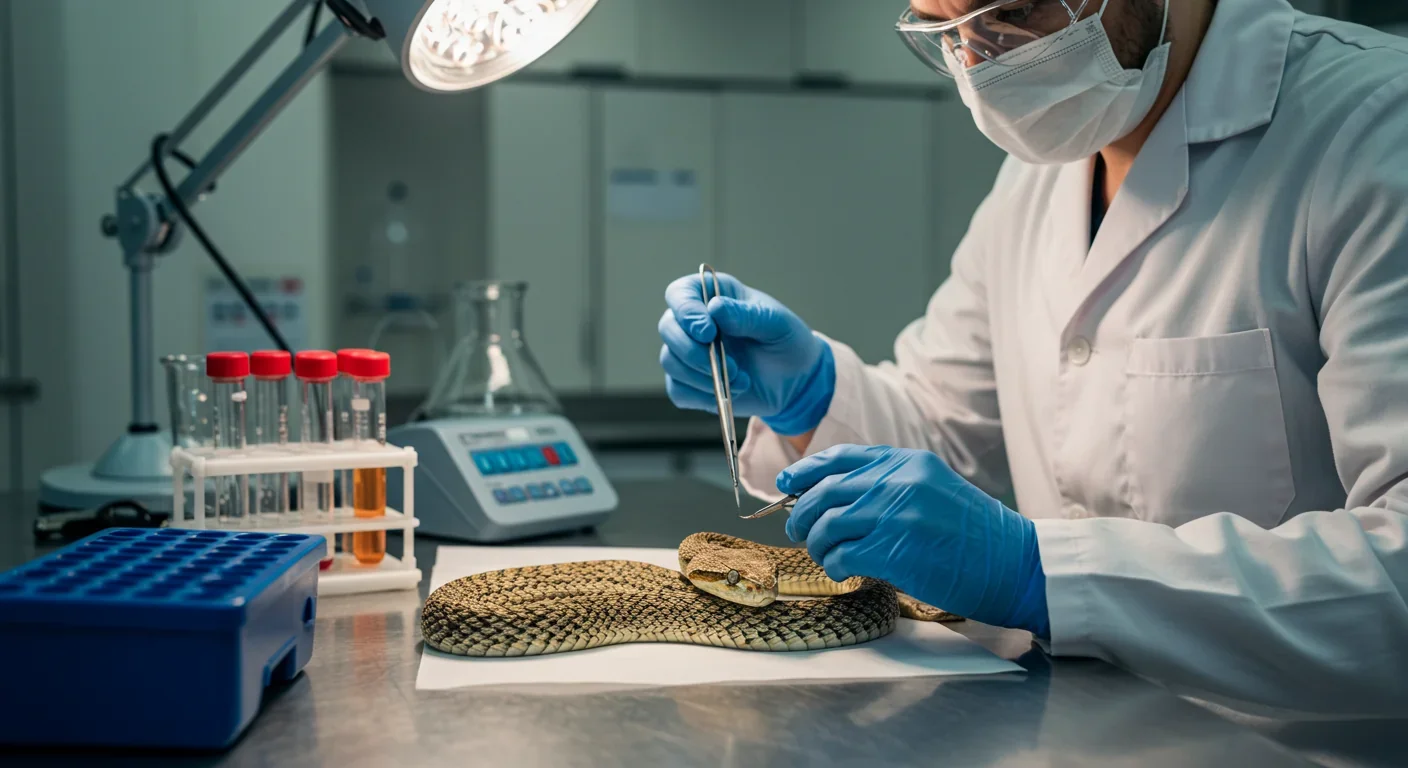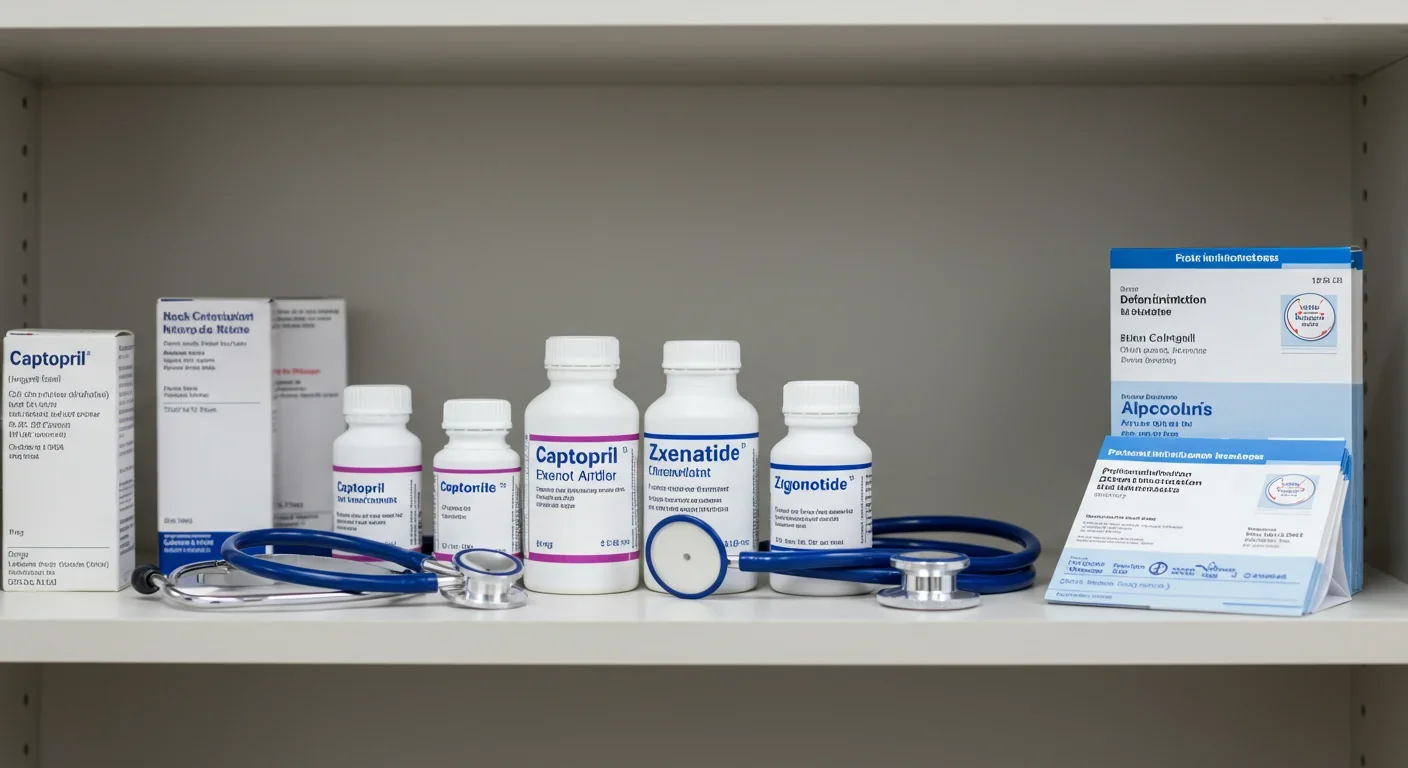Epigenetic Clocks Predict Disease 30 Years Early

TL;DR: Scientists are transforming deadly venoms from snakes, spiders, and marine creatures into life-saving medicines. From captopril for blood pressure to exenatide for diabetes, venom-derived drugs showcase how nature's chemical arsenal can be repurposed for healing.

By 2030, researchers predict that venom-derived therapies could account for more than 15% of all new drug approvals, transforming substances once feared as deadly into precision tools that save millions of lives. Already, dozens of medications trace their origins to the chemical arsenals of snakes, spiders, scorpions, and marine creatures. What started as a curious observation in the 1970s has become a pharmaceutical revolution, one that's reshaping how we treat everything from high blood pressure to diabetes to cancer.
The story begins with a bite that shouldn't have killed, but crashed blood pressure instead. In the early 1970s, researchers studying the Brazilian pit viper (Bothrops jararaca) noticed something peculiar about its venom. While investigating why victims experienced dramatic drops in blood pressure before dying, scientists Miguel Ondetti and David Cushman at Squibb Pharmaceuticals identified peptides that inhibited angiotensin-converting enzyme (ACE), a key regulator of blood pressure.
That observation sparked a methodical effort to convert a deadly toxin into a life-saving drug. Through iterative medicinal chemistry, the team transformed the venom's tripeptide Phe-Ala-Pro into a smaller dipeptide with a thiol group. The result was captopril, which exhibited a thousand-fold greater potency against ACE compared to the parent peptide. Approved by the FDA in 1981, captopril became the first ACE inhibitor and has since prevented countless heart attacks and strokes.
This wasn't just a one-off success. Captopril proved that structure-based design, inspired by nature's chemical warfare, could beat blind screening and catalyze a new era of rational drug discovery. The drug demonstrated that understanding exactly how a venom component binds to its target allows chemists to engineer safer, more effective variants.
Venoms are evolutionary masterpieces. Over millions of years, predators and prey have engaged in a biochemical arms race, producing compounds of extraordinary specificity. A single venom can contain hundreds of distinct peptides, each targeting different receptors, ion channels, or enzymes in the victim's body.
These toxins operate through multiple mechanisms. Some, like cone snail peptides, directly block ion channels such as calcium or sodium channels, disrupting nerve signals. Others modify gating properties of these channels, altering when and how they open. Still others disrupt cell membranes or modulate receptor activity, causing cascading physiological effects.
What makes venom peptides especially valuable is their selectivity. A conotoxin from a marine cone snail, for instance, can bind to one subtype of nicotinic acetylcholine receptor while ignoring dozens of closely related receptors. This precision is nearly impossible to achieve with synthetic small molecules alone, which is why marine invertebrate-derived antimicrobial peptides have attracted intense pharmaceutical interest.

Scientists isolate these peptides through high-throughput sequencing and proteomics. Modern techniques like transcriptomics allow researchers to rapidly identify thousands of venom components, then test them against panels of human receptors and channels. Artificial intelligence now accelerates this process, using machine learning to predict which peptides will bind specific targets before any wet-lab work begins.
Beyond captopril, several venom-derived drugs have reached patients. Ziconotide, marketed as Prialt, comes from the cone snail Conus magus and provides relief for severe chronic pain. Unlike opioids, ziconotide blocks calcium channels in the spinal cord without causing addiction, though it must be delivered via intrathecal pump due to poor oral bioavailability.
For diabetes, exenatide represents a breakthrough. Derived from Gila monster (Heloderma suspectum) venom, exenatide mimics the incretin hormone GLP-1, stimulating insulin secretion only when blood glucose is elevated. In controlled phase 3 trials, exenatide reduced HbA1c by 0.8–1.7% and body weight by 1.2–8.0 kg over 12–52 weeks. The drug's resistance to enzymatic breakdown allows once-daily or even once-weekly dosing, a major advantage over native GLP-1, which lasts only minutes in the bloodstream.
Exenatide's success didn't happen overnight. Early preclinical studies showed it was more than 5,000-fold more potent than GLP-1 in diabetic mice. Clinical trials then confirmed sustained HbA1c reduction for up to 82 weeks, with manageable side effects, mainly mild nausea. This venom-derived peptide has become a cornerstone of type 2 diabetes management, spawning an entire class of GLP-1 receptor agonists.
Cancer researchers are exploring venom peptides, too. The conotoxin α-GeXIVA inhibited cell proliferation in 17 breast cancer lines and induced apoptosis by targeting α9α10 nicotinic acetylcholine receptors on tumor cells. Another conotoxin, α-TxID, not only slowed growth of lung and cervical cancer cells but enhanced the effect of adriamycin, suggesting potential for combination therapy.
These examples illustrate a pattern: venom peptides can simultaneously hit multiple metabolic pathways or cellular targets, offering comprehensive therapeutic strategies for complex diseases. Rather than a single-target approach, venom-derived drugs leverage nature's multi-pronged chemical assault.
Turning venom into medicine follows a well-established process. First, venom is collected, either by "milking" live animals or, increasingly, through synthetic production once the peptide sequence is known. Researchers then fractionate the venom and test each component against disease-relevant targets in vitro.
Promising candidates undergo structural analysis. Techniques like X-ray crystallography and cryo-electron microscopy reveal exactly how a peptide binds to its target. Armed with this atomic-level blueprint, medicinal chemists modify the peptide to improve potency, reduce toxicity, and enhance stability.
Captopril's development exemplifies this iterative refinement. Starting from a nine-amino-acid venom peptide, researchers trimmed it down, replaced key residues, and added a thiol group to mimic the transition state of the enzyme's natural substrate. Each modification was tested, and the best performers advanced. The final drug bore little resemblance to the original venom component but retained its core mechanism.
Modern approaches add computational power to this workflow. Machine learning models can now predict AMP activity from sequence alone, design de novo peptides that don't exist in nature, and optimize them for drug-like properties such as oral bioavailability and metabolic stability. AI-driven platforms screen billions of virtual peptides in silico, identifying lead candidates in days rather than years.
Synthetic biology also plays a role. Once a promising venom peptide is identified, scientists can produce it in bacteria or yeast, avoiding the need to harvest venom from wild animals. Techniques like cyclization and PEGylation further improve peptide drugs, making them resistant to enzymatic degradation and extending their half-lives in the bloodstream.
The pipeline of venom-derived therapies is swelling. Researchers are investigating venom peptides for conditions ranging from autoimmune diseases to neurological disorders to antimicrobial resistance. Twelve distinct venom peptides have been validated for antidiabetic activity, covering insulin signaling, ion channel modulation, and enzyme inhibition. Some are already in preclinical trials.
Pain management remains a major focus. Chronic pain affects hundreds of millions of people worldwide, and current treatments either fail to provide relief or carry risks of addiction. Venom peptides that selectively block pain-related ion channels, such as Nav1.7 sodium channels, promise effective analgesia without the downsides of opioids. Several candidates are in early-stage clinical trials.
Cancer therapy is another frontier. Venom peptides can exploit the unique receptor profiles of tumor cells. Because many cancers express unusual nicotinic acetylcholine receptor subtypes, conotoxins that target these receptors can selectively kill cancer cells while sparing normal tissue. Combining venom peptides with conventional chemotherapy may reduce required doses of toxic drugs, minimizing side effects.

Antimicrobial resistance is driving renewed interest in venom-derived antimicrobial peptides. Marine invertebrates produce peptides with broad-spectrum antibacterial, antifungal, antiviral, and antiparasitic activities. These peptides often kill pathogens through membrane disruption, a mechanism that's hard for bacteria to develop resistance against. As conventional antibiotics lose effectiveness, venom-derived alternatives could fill a critical gap.
Despite the promise, venom-derived drug development faces hurdles. Peptides are expensive to manufacture at scale, and their large size limits oral bioavailability. Many require injection or specialized delivery systems, reducing patient convenience. Stability is another issue: peptides degrade quickly in the body unless chemically modified.
Sourcing venom raises ethical and logistical questions. Harvesting venom from wild animals can stress populations and isn't sustainable at pharmaceutical scales. Captive breeding is one solution, but it's labor-intensive and costly. Synthetic production addresses these concerns but requires knowing the peptide sequence upfront, which demands extensive initial research.
Intellectual property and benefit-sharing also complicate venom bioprospecting. Many venomous species live in biodiverse regions of developing countries. International agreements like the Nagoya Protocol mandate fair sharing of benefits arising from genetic resources, but enforcement is uneven. Pharmaceutical companies must navigate complex legal landscapes to ensure that local communities and nations benefit from drugs derived from their biodiversity.
Safety is paramount. Venom components evolved to harm, not heal, so minimizing off-target effects is essential. Early clinical trials of venom-derived drugs have sometimes revealed unexpected toxicities. Ziconotide, for instance, can cause severe neurological side effects if dosing isn't carefully managed. Rigorous preclinical testing and cautious dose escalation in humans are critical.
Regulatory pathways for peptide drugs are well-established but demanding. Peptide therapeutics must demonstrate safety, efficacy, and manufacturability. The FDA and other agencies require extensive data on pharmacokinetics, immunogenicity, and long-term effects. Meeting these standards is expensive and time-consuming, which is why only a fraction of venom-derived candidates reach the market.
Venom research is inherently international. Biodiversity hotspots, where the most venomous species live, are concentrated in tropical and subtropical regions. Collaborations between universities, pharmaceutical companies, and governments in countries like Brazil, Australia, and Indonesia are accelerating discovery.
In Australia, scientists are cataloging the venom of thousands of spider and snake species, building databases that link peptide sequences to biological activities. Brazil, home to the pit viper that gave us captopril, continues to study its rich herpetofauna for new drug leads. Marine researchers in the Philippines and Indonesia are diving deep to collect cone snails, whose venom diversity is staggering.
Technology transfer is another dimension of global cooperation. Advanced techniques developed in wealthy nations, such as AI-driven peptide design, are being shared with researchers in biodiversity-rich but resource-limited countries. This democratization of tools ensures that the benefits of venom research aren't monopolized by a few institutions.
International conferences and consortia facilitate knowledge exchange. The International Society on Toxinology brings together scientists from dozens of countries to share findings, standardize methods, and coordinate efforts. Open-access databases of venom peptide sequences and structures enable researchers worldwide to build on each other's work without duplicating effort.
Venom-derived drugs represent more than a collection of novel therapeutics; they embody a shift in how we discover medicines. For decades, pharmaceutical companies screened synthetic chemical libraries, hoping to stumble upon compounds that hit disease targets. This approach yielded successes but also many failures, as synthetic molecules often lacked the specificity needed for safe, effective drugs.
Nature, through evolution, has already conducted trillions of experiments. Venom peptides are pre-optimized for binding efficiency and selectivity, honed over millennia. By starting with these natural leads, scientists skip much of the trial-and-error phase. Structure-based design then refines them into drugs with the right balance of potency, safety, and manufacturability.
This bio-inspired strategy is expanding beyond venom. Researchers are mining other natural sources, from microbial metabolites to plant alkaloids, using similar principles. But venom remains uniquely valuable because its components are designed to interact with animal physiology, making them especially relevant for human medicine.
The success of captopril, exenatide, and ziconotide has validated the venom-to-drug pipeline. Investors and pharmaceutical companies, once skeptical of peptide therapeutics, are now pouring resources into venom research. Startups specializing in venom bioprospecting are emerging, armed with cutting-edge sequencing and AI tools.
Within the next decade, we'll likely see a surge of venom-derived drugs targeting conditions that have eluded conventional therapies. Chronic pain, antibiotic-resistant infections, and precision oncology are prime candidates. Advances in peptide chemistry, such as stapled peptides and bicyclic structures, will overcome current limitations in stability and delivery.
Personalized medicine could benefit, too. Venom peptides' exquisite selectivity makes them ideal for targeting specific receptor subtypes expressed in individual patients' tumors or disease states. Diagnostic tools that profile a patient's receptor expression could guide selection of the most effective venom-derived drug.
Public awareness and acceptance will grow as more venom drugs reach the market and demonstrate their value. The narrative will shift from "venom is dangerous" to "venom is a treasure trove of cures." Education campaigns highlighting success stories like captopril and exenatide will help dispel fears and build support for continued research.
Regulatory agencies are also adapting. As peptide and biologics pipelines mature, approval pathways are becoming more predictable. Guidance documents on developing peptide therapeutics provide clearer roadmaps for companies, reducing uncertainty and accelerating timelines.
Collaboration between academia, industry, and government will be essential. Academic labs excel at fundamental discovery, companies at development and commercialization, and governments at funding and regulation. When these sectors align, the pace of progress quickens dramatically.
Venom-derived drugs exemplify how understanding nature's solutions can unlock transformative therapies. From a deadly snakebite to a pill that controls blood pressure, from a lizard's venom to a shot that manages diabetes, the journey is both scientifically elegant and profoundly human. We've learned to respect these chemical weapons, decode their secrets, and repurpose them for healing.
The future is bright. With AI accelerating discovery, synthetic biology enabling sustainable production, and global collaboration pooling knowledge, the next generation of venom-derived medicines is already in the pipeline. Millions more people will benefit from drugs born in the fangs, stingers, and spines of the world's most venomous creatures.
This isn't just about finding new drugs. It's about reimagining our relationship with nature, recognizing that even the most feared organisms hold keys to our survival. As we face rising chronic disease burdens and antibiotic resistance, venom research offers hope grounded in billions of years of evolution. The challenge now is to harness that potential responsibly, equitably, and sustainably.

Recent breakthroughs in fusion technology—including 351,000-gauss magnetic fields, AI-driven plasma diagnostics, and net energy gain at the National Ignition Facility—are transforming fusion propulsion from science fiction to engineering frontier. Scientists now have a realistic pathway to accelerate spacecraft to 10% of light speed, enabling a 43-year journey to Alpha Centauri. While challenges remain in miniaturization, neutron management, and sustained operation, the physics barriers have ...

Epigenetic clocks measure DNA methylation patterns to calculate biological age, which predicts disease risk up to 30 years before symptoms appear. Landmark studies show that accelerated epigenetic aging forecasts cardiovascular disease, diabetes, and neurodegeneration with remarkable accuracy. Lifestyle interventions—Mediterranean diet, structured exercise, quality sleep, stress management—can measurably reverse biological aging, reducing epigenetic age by 1-2 years within months. Commercial ...

Data centers consumed 415 terawatt-hours of electricity in 2024 and will nearly double that by 2030, driven by AI's insatiable energy appetite. Despite tech giants' renewable pledges, actual emissions are up to 662% higher than reported due to accounting loopholes. A digital pollution tax—similar to Europe's carbon border tariff—could finally force the industry to invest in efficiency technologies like liquid cooling, waste heat recovery, and time-matched renewable power, transforming volunta...

Humans are hardwired to see invisible agents—gods, ghosts, conspiracies—thanks to the Hyperactive Agency Detection Device (HADD), an evolutionary survival mechanism that favored false alarms over fatal misses. This cognitive bias, rooted in brain regions like the temporoparietal junction and medial prefrontal cortex, generates religious beliefs, animistic worldviews, and conspiracy theories across all cultures. Understanding HADD doesn't eliminate belief, but it helps us recognize when our pa...

The bombardier beetle has perfected a chemical defense system that human engineers are still trying to replicate: a two-chamber micro-combustion engine that mixes hydroquinone and hydrogen peroxide to create explosive 100°C sprays at up to 500 pulses per second, aimed with 270-degree precision. This tiny insect's biochemical marvel is inspiring revolutionary technologies in aerospace propulsion, pharmaceutical delivery, and fire suppression. By 2030, beetle-inspired systems could position sat...

The U.S. faces a catastrophic care worker shortage driven by poverty-level wages, overwhelming burnout, and systemic undervaluation. With 99% of nursing homes hiring and 9.7 million openings projected by 2034, the crisis threatens patient safety, family stability, and economic productivity. Evidence-based solutions—wage reforms, streamlined training, technology integration, and policy enforcement—exist and work, but require sustained political will and cultural recognition that caregiving is ...

Every major AI model was trained on copyrighted text scraped without permission, triggering billion-dollar lawsuits and forcing a reckoning between innovation and creator rights. The future depends on finding balance between transformative AI development and fair compensation for the people whose work fuels it.